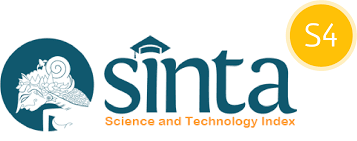Analisis Klasifikasi Konsentrasi Mahasiswa Menggunakan Algoritma K-Nearest Neighbor
DOI:
https://doi.org/10.29408/jit.v7i2.27084Keywords:
Classification, Concentration, K-Nearest NeighborAbstract
Hamzanwadi University located in West Nusa Tenggara boasts a Faculty of Engineering, which plays a pivotal role in delivering top-notch higher education. This faculty offers four highly coveted programs—Informatics Engineering, Information Systems, Computer Engineering, and Environmental Engineering—that attract a significant number of students. The increase in enrollment in these programs underscores the faculty's success, particularly owing to the promising job opportunities in these fields. Nevertheless, students often encounter intricate challenges when selecting their area of specialization that resonates with their interests and capabilities. In addressing this concern, the Faculty of Engineering at Hamzanwadi University provides diverse concentration options like Data Science, RPL, and Multimedia. To aid students in making informed decisions regarding their study concentration, this study employs the K-Nearest Neighbor (KNN) algorithm to analyze the classification of student concentrations. This research adopts an experimental approach and utilizes data collection methods such as observation, interviews, and surveys. The dataset comprises seven attributes including NIM, Gender, GPA, Data Science Course Grade, RPL Course Grade, and Multimedia Course Grade, processed using the KNN algorithm through Google Colab. The research outcomes reveal that with k=2 and 8-fold cross-validation, the achieved accuracy stands at 67%.
References
Wattimury, F.K., & Seniwati, E. (2019). Penentuan Peminatan Mahasiswa Prodi Informatika di Universitas AMIKOM Yogyakarta Menggunakan SVM. INTECHNO Journal, 1(4), 15. e-ISSN: 2655-1438. p-ISSN: 2655-1632.
Kurniawan, Y. I., & Barokah, T. I. (2020). Klasifikasi Penentuan Pengajuan Kartu Kredit Menggunakan K-Nearest Neighbor. Jurnal Ilmiah MATRIK, 22(1), 73. ISSN: 1411-1624. e-ISSN: 2621-8089.
Sagita, R., Enri, U., & Primajaya, A. (2020). Klasifikasi Berita Clickbait Menggunakan K-Nearest Neighbor (KNN). Journal of Information System, 5(2), 230-239. DOI: 10.33633/joins.v5i2.3705.
Pratama, A., Ma'ruf, F. A., Rinaldi, I. A. R., & Faturrhohman. (2021). Klasifikasi Penerima Beasiswa Dengan Menggunakan Algoritma K Nearest Neighbor. Jurnal Data Science & Informatika, 1(1), 11-15.
Malik, L. A. R., Kamayani, M., & Hasan, F. N. (2023). Faktor-Faktor yang Mempengaruhi Minat Calon Mahasiswa Baru Mendaftar pada FTII UHAMKA Menggunakan Algoritma K-Nearest Neighbor (K-NN). Infotech: Journal of Technology Information, 9(1), 85.
Lizarti, N., & Ulfah, A.N. (2019). Penerapan Algoritma K-Nearest Neighbor Untuk Penentuan Peminatan Studi STMIK Amik Riau. Fountain of Informatics Journal, 4(1), 1. ISSN: 2541-4313 (Print) / 2548-5113 (Online).
Putri, A., Hardiana, C. S., Novfuja, E., Siregar, F. T. P., Rahmaddeni, Y., Fatma, Y., & Wahyuni, R. (2023). Comparison of K-NN, Naive Bayes and SVM Algorithms for Final-Year Student Graduation Prediction. MALCOM: Indonesian Journal of Machine Learning and Computer Science, Vol. 3, Iss. 1, April 2023, pp: 20-26. ISSN(P): 2797-2313, ISSN(E): 2775-8575.
Wibowo, A.M., Kasih, P., & Farida, I.N. (2024). Sistem Bantu Penentuan Konsentrasi Mahasiswa Menggunakan Metode K-Nearest Neighbor Classification. Dalam Prosiding Seminar Nasional Teknologi dan Sains Tahun 2024, Vol. 1. Program Studi Teknik Informatika, Universitas Nusantara PGRI Kediri. e-ISSN: 2828–299X.
A. Y. Perdana, R. Latuconsina, A. Dinimaharawati, and U. Telkom, “Prediksi Stunting Pada Balita Dengan Algoritma Random,” vol. 8, no. 5, pp. 6650–6656, 2021.
M. Asrol, P. Papilo, and F. E. Gunawan, “ScienceDirect Procedia ScienceDirect ScienceDirect Support Vector Machine with K-fold Validation to Improve the Support Vector Machine with K-fold Validation to Improve the Industry ’ s Sustainability Performance Classification Industry ’ s Sustainability,” Procedia Comput. Sci., vol. 179, no. 2020, pp. 854–862, 2021, doi: 10.1016/j.procs.2021.01.074.
A. Residencia, “Klasifikasi Kelayakan Peserta Pengajuan Kredit Rumah Dengan Algoritma Naïve Bayes Di Perumahan Azzura Residencia,” vol. 9, pp. 43–48, 2019.
M. Azhari, “Perbandingan Akurasi , Recall , dan Presisi Klasifikasi pada Algoritma C4.5,Random Forest, SVM, dan Naive Bayes,” vol. 5, no. April, pp. 640–651, 2021, doi: 10.30865/mib.v5i2.2937.
Y. Yahya and H. Bahtiar, “Pengaruh Pertumbuhan Ekonomi Terhadap Tingkat Kesejahteraan Masyarakat Kecamatan Selong Kabupaten Lombok Timur – Nusa Tenggara Barat Menggunakan Algoritma Naive Bayes,” Infotek J. Inform. dan Teknol., vol. 4, no. 1, pp. 20–28, 2021, doi: 10.29408/jit.v4i1.2981.
M. Saiful1*, Syamsuddin2, and Moh. Farid Wajdi3, “Implementasi Algoritma Naive Bayes Untuk Memprediksi Predikat Ketuntasan Belajar Siswa Pasca Pandemi Covid 19,” Infotek J. Inform. dan Teknol., vol. 4, no. 1, pp. 96–104, 2021.
B. A. Candra Permana and I. K. Dewi Patwari, “Komparasi Metode Klasifikasi Data Mining Decision Tree dan Naïve Bayes Untuk Prediksi Penyakit Diabetes,” Infotek J. Inform. dan Teknol., vol. 4, no. 1, pp. 63–69, 2021, doi: 10.29408/jit.v4i1.2994
Downloads
Published
How to Cite
Issue
Section
License
Copyright (c) 2024 Infotek: Jurnal Informatika dan Teknologi

This work is licensed under a Creative Commons Attribution 4.0 International License.
Semua tulisan pada jurnal ini menjadi tanggung jawab penuh penulis. Jurnal Infotek memberikan akses terbuka terhadap siapapun agar informasi dan temuan pada artikel tersebut bermanfaat bagi semua orang. Jurnal Infotek ini dapat diakses dan diunduh secara gratis, tanpa dipungut biaya sesuai dengan lisense creative commons yang digunakan.
Jurnal Infotek is licensed under a Creative Commons Attribution 4.0 International License.
Statistik Pengunjung




